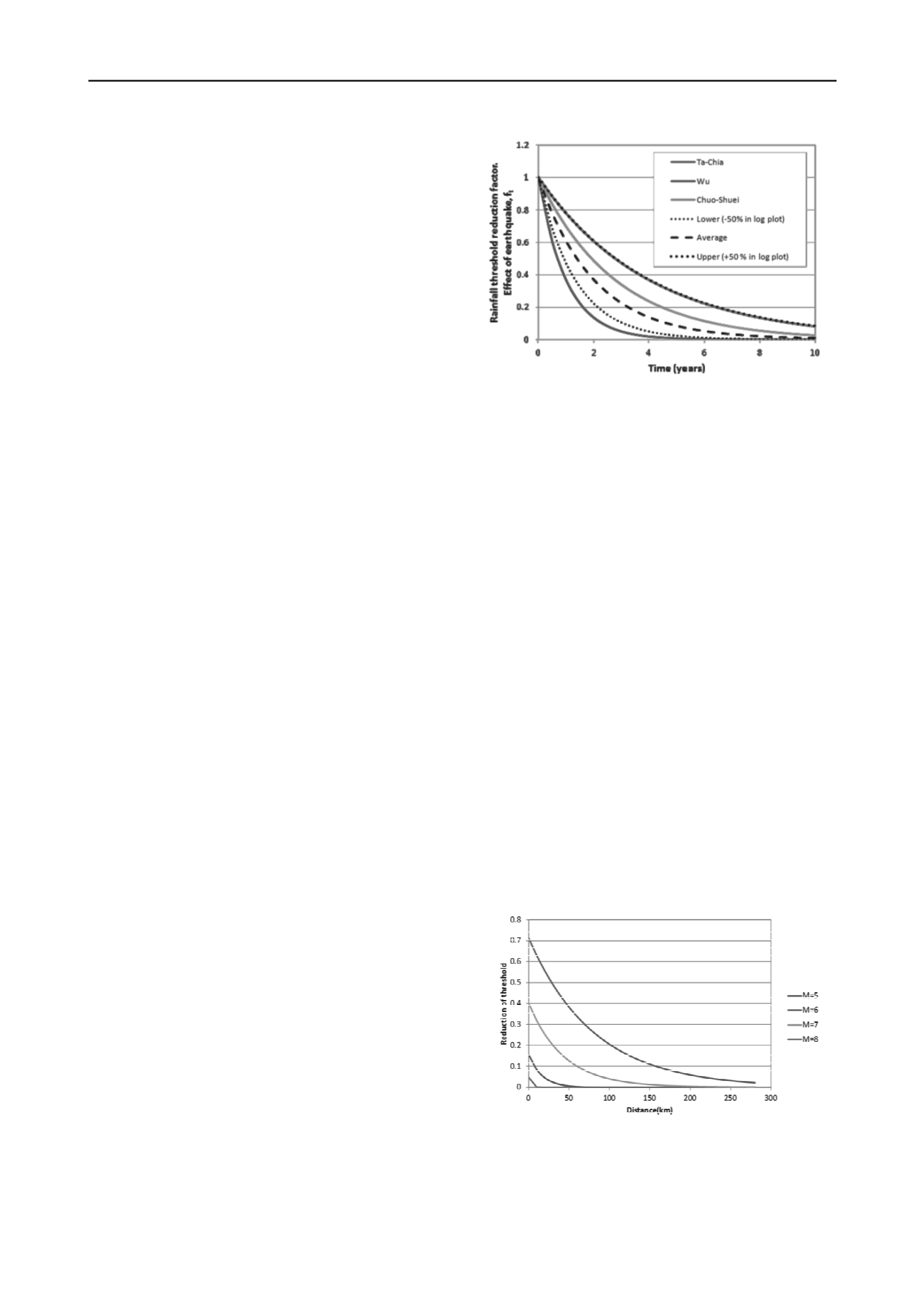
2238
Proceedings of the 18
th
International Conference on Soil Mechanics and Geotechnical Engineering, Paris 2013
The temporal and spatial effects are independent and thus
the spatial and temporal variations are treated separately in
two different functions and multiplied to find the actual
rainfall threshold reduction.
The earthquake effect is included into the spatial model.
The temporal model is a normalized model representing
the remaining threshold reduction as a function of time af-
ter the earthquake.
According to the assumptions above, the threshold reduction for
a given point in time and space is a product of the spatial model
and the temporal model (Eq. 1):
Threshold reduction (X, T, M) =
f
spatial
(X, M) · f
t
(T)
Eq.(1)
In this model, X is the distance to the epicenter, T is the time af-
ter the earthquake and M is the earthquake magnitude. The pur-
pose of the model is to relate the post-earthquake rainfall
threshold to the pre-earthquake threshold using the derived
threshold reduction function (Eq. 2):
Post-earthquake threshold = (1 - Threshold
reduction(X, T, M))·Pre-earthquake threshold
Eq.(2)
The rainfall threshold changes referred to in the model is the
numerical value of the mean rainfall intensity for a duration of
one hour, i.e. α in Eq. 3 below:
I = αD
β
Eq.(3)
In this equation, I is the mean rainfall threshold intensity, D is
the rainfall duration in hours and β is the slope of the threshold
curve in log-log space.
2.1
Rainfall threshold reduction as function of time
Shou et al. (2011) modelled the effect of earthquake on the rain-
fall threshold reduction by an exponentially decaying function
with time. The model parameter could be transferred to cumula-
tive precipitation by using the annual mean precipitation. In the
proposed model, the variations caused by other relevant pa-
rameters, such as slope angle and actual precipitation, are not
treated explicitly; but model uncertainty is added to account for
such variations. Shou et al. (2011) provided some data on the
temporal effect of the Chi-Chi earthquake. No such data exist
for the Wenchuan earthquake. From the available data it appears
that the temporal behavior is site-dependent. However, Shou et
al. (2011) used a model representing the average of three sites in
Taiwan. Model uncertainty was introduced by two curves repre-
senting uncertainty bands. The uncertainty bands represent de-
viations of ±50% from the average curve in a semi-log coordi-
nate system.
Figure 1 shows the variation of the normalized rainfall
threshold reduction with time for three different locations in
Taiwan together with the average curve and uncertainty bands.
The figure illustrates the long-term effects after the Chi-chi
earthquake.
Fig. 1 Remaining rainfall threshold reduction (i.e. rainfall threshold reduc-
tion factor) as a function of time for three locations in Taiwan (colored
curves) as well as an average curve and curves representing model uncer-
tainty (black curves).
2.2
Rainfall threshold reduction as function of distance and
earthquake magnitude
The rainfall threshold reduction as a function of earthquake
magnitude and distance from the epicenter is based on the fol-
lowing relations and assumptions:
For the spatial variation, the effect of earthquake on the
rainfall threshold reduction is assumed to decay exponen-
tially with distance from the epicenter/fault. This assump-
tion is based on observations after the Chi-Chi earthquake
by Khazai & Sitar (2003).
The maximum “influence radius” of an earthquake is a
function of the magnitude. The function described by
Keefer (1984) is applied. This function describes the
maximum distance from epicenter for seismically induced
landslides as a function of earthquake magnitude. It was
further assumed that at for a distance equal to the influence
distance of the earthquake, the rainfall threshold reduction
was 1/100 of the rainfall threshold reduction at distance 0.
The model for maximum rainfall threshold reduction as a
function of magnitude is assumed to increase with increas-
ing magnitude.
Based on the above mentioned relations, a conceptual model
for rainfall threshold reduction as a function of earthquake
magnitude and distance from epicenter may be established as il-
lustrated in Figure 2.
Fig. 2 Reduction of rainfall threshold caused by earthquake as a function
of magnitude and distance
2.3
Linking rainfall threshold reduction and reduction of soil
shear strength
Post-earthquake soil strengths may be lower than pre-
earthquake (static) strengths for zones that are susceptible to


